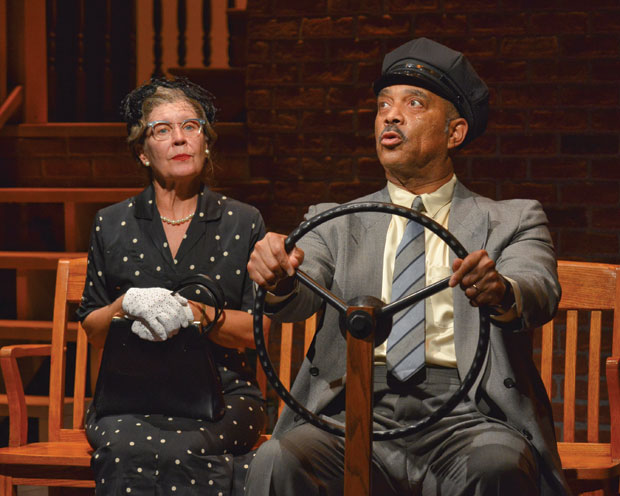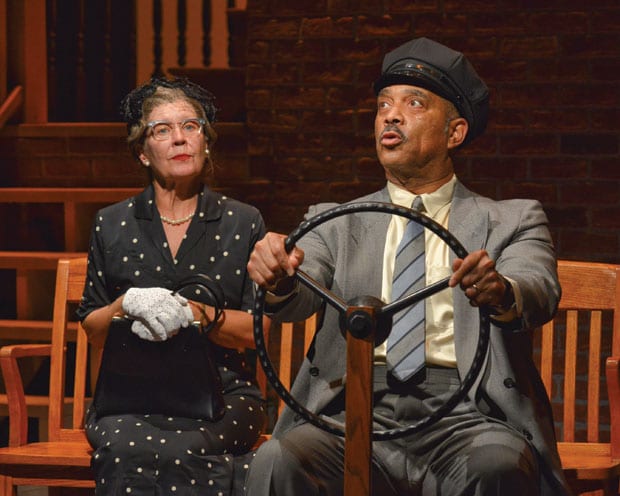
SHIFTING GEARS | Daisy (Annalee Jefferies) clucks her rules at a bemused Hoke (Hassan Al-Amin) in DTC’s charmingly platonic romance ‘Driving Miss Daisy.’ (Photo courtesy Karen Almond)
ARNOLD WAYNE JONES | Executive Editor
 The film version of Driving Miss Daisy was one of those delightful confluences of popular appeal and critical acclaim — so pervasively loved that it’s easy to forget it started life as a simple three-character, one-act off-Broadway play. Who does a play about a car, anyway? (Actually, from Chitty Chitty Bang Bang to The Grapes of Wrath, way too many. I expect Christine: The Musical any day now.)
The film version of Driving Miss Daisy was one of those delightful confluences of popular appeal and critical acclaim — so pervasively loved that it’s easy to forget it started life as a simple three-character, one-act off-Broadway play. Who does a play about a car, anyway? (Actually, from Chitty Chitty Bang Bang to The Grapes of Wrath, way too many. I expect Christine: The Musical any day now.)
But as anyone can tell you who has seen a stage production of Driving Miss Daisy, now at the Kalita courtesy of DTC, this isn’t a play “about” a car, or even “about” driving. It’s a love story, told in the rearview mirror.
Spanning more than two decades, from the 1940s to the 1970s, Daisy is a character study of very particular characters: Daisy (Annalee Jefferies), a prickly 72-year-old Jewish lady living in the Jim Crow South, but who fancies herself a liberal for her day; and Hoke (Hassan Al-Amin), the illiterate, late-middle-aged black man hired by her son (James Crawford) to chauffeur her around once her driving skills are called into question.
Even if you didn’t read the program notes, you’d suspect that it was based on relatives of the author, Alfred Uhry. It has that specificity and uniqueness, from the surprisingly lengthy endurance of the Daisy-Hoke relationship to the conflicts that arise between them. Daisy doesn’t like having a servant, which makes her seem rich … even though she is. She doesn’t like the lack of freedom not driving implies, though she’s smart enough to know she’d kill everyone in the neighborhood if she got behind the wheel again. There are driving scenes (staged abstractly, with plain benches and a steering wheel standing in for the car), but the main effect of those moments are to chronicle the dynamic between Daisy (in the backseat, sniping constantly) and Hoke (affably treating her with respect). The real action takes place in the space between, where nods, gestures and silences convey the development of a love affair — not physical, perhaps, but no less tender and meaningful.
The DTC’s quaint set, mounted on the Kalita’s famed turntable, spins so often that it can almost make you dizzy, but the movement is leisurely, like a slow stroll from one event to another indicative not just of the passage of time, but the growth of the characters. Jefferies ages with shocking convincingness from the spry septuagenarian to the senile shell of a woman near her century mark; when she stands to take her bow, you can sense the audience’s surprise that she’s that energetic. Al-Amin captures Hoke’s mix of tolerance and defiance deftly. At a breezy 80 minutes, Joel Ferrell has fashioned a reliable little charmer for an evening’s entertainment.
This article appeared in the Dallas Voice print edition October 31, 2014.

